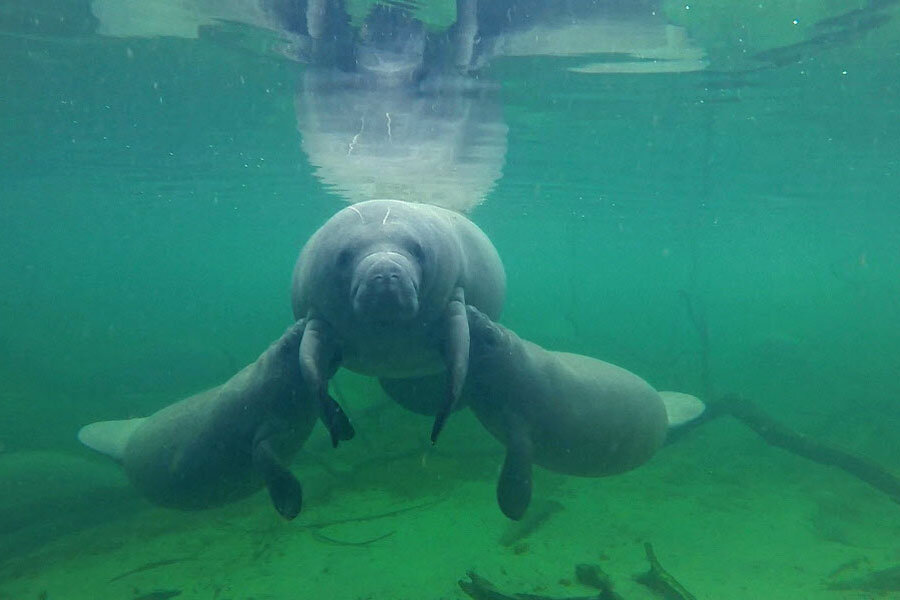Record number of endangered manatees spotted in Florida's annual count
Loading...
Florida wildlife officials report finding record-high number of manatees during their annual aerial survey.
Surveyors counted 6,063 manatees, or sea cows, as they’re sometimes called, during February flyovers along the state’s east and west coastline, topping the previous high-count found in 2010 by nearly 1,000 individuals.
“Counting this many manatees is wonderful news,” said Richard Corbett, chairman of the Fish and Wildlife Commission said in a statement Monday. “The high count this year shows that our long-term conservation efforts are working.”
Florida conservationists have fiercely guarded manatees for decades. In the 1970s, there were believed to be just 700 individuals. Since that time, the populations have increased considerably and they have started to expand their range a bit beyond Florida's waters.
The 800-pound, 10-foot-long vegetarians are docile, defenseless creatures. Curious by nature, the gentle giants can get themselves into trouble by venturing places where most other animals not dare go. In February, 19 manatees managed to get stuck in an underground pipe after seeking refuge from the cold. State wildlife personnel employed heavy machinery, makeshift slings, even a fire ladder truck to rescue the herd, evidence of the state's devotion to protecting the creatures.
While the number of manatees identified during the survey is encouraging, conservationists are cautious about counting the high count as evidence of a recovery or a signal that the sea mammals should be delisted from the Endangered Species List.
The survey, coordinated by the Florida Fish and Wildlife Conservation Commission, was not meant to be a population estimate and does not necessarily mean that there are actually 1,000 more manatees in Florida waters this year compared with five years ago, explains FWC biologist Holly Edwards.
“Anytime you see an increase in counts, that’s positive. It gives you confidence that things are going well,” Dr. Edwards says. “However, we know we miss animals during the survey and what we did not do in this particular survey is estimate the number that we think we may have missed.”
In addition, there could be other factors at play leading to the larger count. Optimal weather conditions and chance likely played a role in the number of individuals the surveyors were able to spot, Edwards explains.
"Once we get to these locations to do a flyover, they need to be up on the surface and available to the person on the airplane to be seen," she says.
Though inconclusive, the boost seen during the survey is promising given recent mortality events seen in recent years. In 2010, hundreds of manatees died as a result of cold stress syndrome. In 2013, some 800 manatees died during a red tide algal bloom.
A population of 6,000, while higher than seen before, still isn’t terribly large, considering a single event can potentially wipe out 800 individuals, says Patrick Rose, executive director of the Save the Manatee Club advocacy organization in Maitland, Fla.
“When it comes to determining whether a population is likely to endure or is safe, the number of 6,000 manatees is not a good number,” Mr. Rose says. “There are species [of other animals] that have had millions in their populations and have gone extinct.”
Rose, an aquatic biologist, has spent 40 years working to help protect Florida’s manatees. In that time, the state has taken numerous steps to safeguard the species. In 1978, Florida designated the entire state a “refuge and sanctuary" for manatees. Since then, the state has established boat-free sanctuaries and implemented speed zones for boats.
Recreational boating continues to pose the most consistent threat to the Florida manatee, a subspecies of the West Indian manatee. Most, if not all, living manatees bear scars from collisions with watercraft, Rose says. Those accidents could have been fatal, if the boats had not been adhering to speed limits.
“Over the long haul, I think we can feel comfortable that what people have been doing over the last 30 to 40 years has helped this population,” FWC’s Edwards says.
In addition to helping to reduce watercraft strikes, efforts to clean up the state's water bodies and to mitigate and restore springs has helped to preserve the manatees' habitat.
However, Rose and Edwards both caution that changes in climate are likely to exacerbate some of the existing challenges facing manatees, such as red tide and cold weather events. And climate change could very well bring some new challenges as well.
Sea-level rise is likely to negatively impact the manatees' ability to access sea grass, a staple of the vegetarian sea mammals’ diet.
As waters rise and people fortify the coasts to protect the infrastructure, “water is not going to be allowed to naturally flow in and create a shoreline,” Edwards says. “The water is going to get deeper. And when you get deeper, more turbid water, you get less sea grass.”
Rose and Edwards caution that the good-news story of a record-high number of manatees counted today should not overshadow these potential threats looming in the not so distant future.
“Even though things may be going well now, there are things that are looming out there that could change the course of how the manatees are doing,” Edwards says.






